Savills Bundle
Who Really Owns Savills?
Unraveling the Savills SWOT Analysis reveals a complex web of stakeholders, making understanding its ownership structure essential. Knowing the Savills owner and Savills ownership provides critical insights into its strategic direction and market positioning within the competitive Savills real estate landscape. From its humble beginnings to its current global footprint, the evolution of the Savills company is a fascinating study in corporate growth.
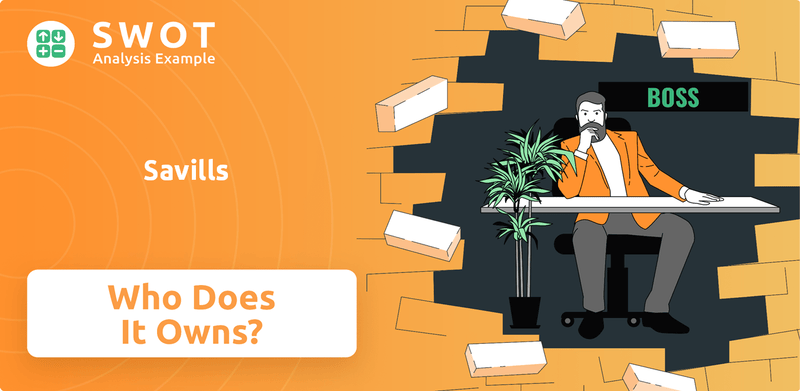
Tracing the Savills history back to its founding in 1855 by Alfred Savill, and understanding its transformation into a publicly traded entity in 1988, offers a clear picture of its current structure. The company's Savills headquarters in London serves as the nerve center for its global operations, overseeing a vast network of services that generated £2.40 billion in revenue by 2024. This exploration will delve into the details of Savills company information, including its major shareholders and governance framework.
Who Founded Savills?
The story of Savills, a prominent player in the real estate market, began in 1855. Alfred Savill, born in 1829, established 'Savill and Son' in London, marking the genesis of what would become a global real estate giant. Initially, the firm's focus was on agricultural property, reflecting Alfred Savill's expertise and connections within the Essex lordships.
By the time of Alfred Savill's passing in 1905, his sons, Alfred, Edwin, and (Henry) Norman, had already joined the firm. This ensured the family's continued involvement and leadership. The early structure of the company was typical of a family-run business, with the Savill family holding significant control and shaping the company's vision.
The evolution of the company from its agricultural roots to a broader real estate service provider is a key part of the Savills history. The company's expansion into new areas, such as rating surveying and commercial property investment, was driven by strategic mergers. This expansion marked a shift from a family-centered ownership to a more diverse structure.
Alfred Savill founded the company in 1855. The initial focus was on agricultural property, reflecting his expertise. The firm started at 27 Rood Lane, EC3, in London.
Alfred Savill's sons became partners before his death in 1905. This ensured the continuation of the family's role. The early structure was characteristic of a family-run business.
The company expanded into new service lines through mergers. The 1950s saw mergers, such as with Rees-Reynold and Hunt. The firm was rebranded as Savills in the 1970s.
Savills was incorporated as a limited company in 1987. The company achieved a full listing on the London Stock Exchange in 1988. This marked a significant change in the Savills marketing strategy.
Early ownership was primarily within the Savill family. Strategic mergers expanded the company's services and ownership. The shift led to a more diversified ownership structure.
1855: Foundation of 'Savill and Son'. 1905: Alfred Savill's death. 1970s: Rebranding to Savills. 1987: Incorporation as a limited company. 1988: Full listing on the London Stock Exchange.
The initial ownership of Savills was firmly rooted in the Savill family, reflecting its origins as a family-run business. The evolution of Savills from a focus on agricultural property to a diversified real estate service provider was facilitated by strategic mergers and acquisitions. The transition to a public company in 1988 marked a significant change in the Savills company structure and ownership.
- Early Ownership: Primarily controlled by the Savill family.
- Expansion: Mergers expanded services and ownership.
- Public Listing: Transformed the company structure.
- Current Status: A publicly traded company.
Savills SWOT Analysis
- Complete SWOT Breakdown
- Fully Customizable
- Editable in Excel & Word
- Professional Formatting
- Investor-Ready Format
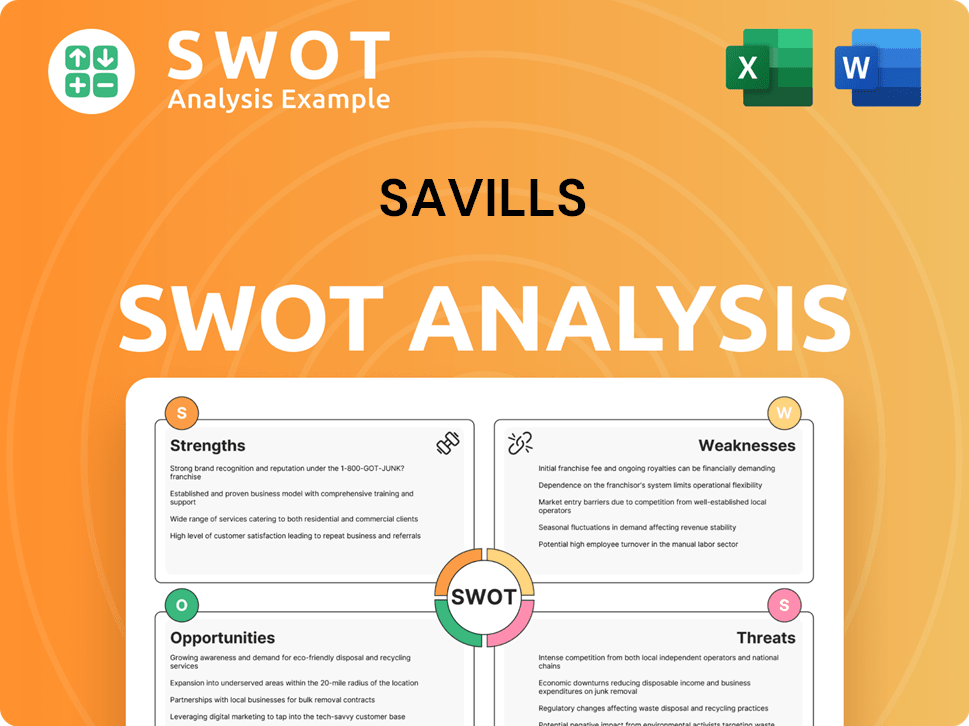
How Has Savills’s Ownership Changed Over Time?
The ownership structure of Savills has transformed significantly since its initial public offering (IPO) in 1988. The company's move into the FTSE 250 in 2000 marked a key step, transforming it into a publicly traded entity. This shift opened the door for a diverse range of investors, from institutional giants to individual shareholders, to hold stakes in the company. This evolution reflects Savills' growth and its integration into the broader financial market.
As a publicly listed entity, Savills' ownership is primarily distributed among institutional investors, mutual funds, and individual shareholders. The company's ownership structure is subject to change based on market dynamics and investment decisions. The presence of significant institutional investors often indicates a level of confidence in the company's long-term prospects and strategic direction. The financial performance, such as the revenue growth of 7.42% from £2.24 billion to £2.40 billion in 2024, and net income improvement by 31.37% from £40.80 million to £53.60 million, can also influence ownership trends.
| Shareholder | Stake | Shares (as of May 2025) |
|---|---|---|
| Fidelity Management & Research Company LLC | 6.827% | 9,870,190 |
| Evenlode Investment Management Ltd. | 4.978% | 7,195,884 |
| The Vanguard Group, Inc. | N/A | N/A |
As of May 2025, Savills plc has 91 institutional owners and shareholders, collectively holding a total of 21,711,974 shares. Major institutional shareholders include Fidelity Management & Research Company LLC, holding 6.827% of equities with 9,870,190 shares, and Evenlode Investment Management Ltd., with 4.978% of equities, totaling 7,195,884 shares. Other significant investors include The Vanguard Group, Inc., and BlackRock, Inc. These significant holdings demonstrate a broad base of ownership typical for a company listed on the FTSE 250, influencing company strategy and governance.
The ownership of Savills is diverse, with institutional investors playing a significant role. This structure reflects the company's status as a publicly traded entity and its integration into the broader financial market.
- Institutional investors hold a substantial portion of shares.
- Major shareholders can influence company strategy.
- The company's financial performance impacts ownership trends.
- Savills Investment Management benefits from its parent company.
Savills PESTLE Analysis
- Covers All 6 PESTLE Categories
- No Research Needed – Save Hours of Work
- Built by Experts, Trusted by Consultants
- Instant Download, Ready to Use
- 100% Editable, Fully Customizable
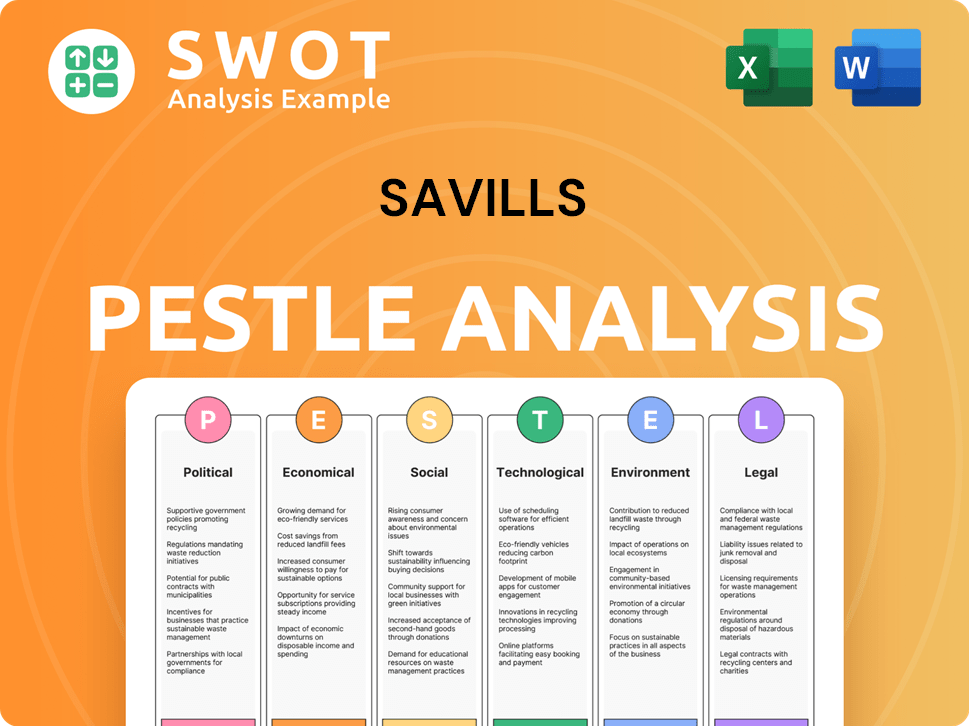
Who Sits on Savills’s Board?
The current Board of Directors of the [Company Name], as of May 2025, is led by Chair Stacey Cartwright, who assumed the role in January 2024. The board includes both executive and non-executive directors, ensuring a balance of perspectives in guiding the company. Executive leadership includes Mark Ridley, the Group Chief Executive, who is scheduled to retire at the end of 2025, and Simon Shaw, the current Group Chief Financial Officer, who will take over as Group Chief Executive on January 1, 2026. Other directors re-elected at the 2025 Annual General Meeting include Florence Tondu-Mélique, Dana Roffman, Philip Lee, Richard Orders, Marcus Sperber, John Waters, and Adriana Karaboutis.
The composition of the board reflects a commitment to experienced leadership and diverse expertise. This structure is crucial for overseeing the strategic direction and governance of the company. The directors play a vital role in ensuring that the company operates in the best interests of its shareholders and stakeholders. This includes monitoring financial performance, approving major decisions, and ensuring compliance with regulations.
| Director | Role | Appointment Date |
|---|---|---|
| Stacey Cartwright | Chair | January 2024 |
| Mark Ridley | Group Chief Executive | N/A |
| Simon Shaw | Group Chief Financial Officer (Incoming Group Chief Executive) | N/A |
The company operates under a one-share-one-vote structure. As of March 19, 2025, the total voting rights in the company were 144,567,706. Each ordinary share carries one vote. The Board recommends that shareholders vote in favor of all proposed resolutions at the Annual General Meeting, and the directors themselves intend to do so for their own shareholdings. The company's commitment to shareholder interests is evident in its rigorous processes for setting director remuneration and its engagement with shareholders on proposed resolutions. For instance, the 2024 Annual Report and Accounts, including the Directors' Remuneration Report, were made available to shareholders for approval at the May 2025 AGM. For more insights, you can explore the Growth Strategy of Savills.
The Board of Directors plays a key role in the governance of Savills, ensuring strategic oversight and representing shareholder interests. The company uses a one-share-one-vote system, with a significant number of total voting rights. Shareholders have the opportunity to vote on key resolutions, including director remuneration.
- Stacey Cartwright is the Chair of the Board.
- Mark Ridley is the current Group Chief Executive until the end of 2025.
- Simon Shaw will become Group Chief Executive on January 1, 2026.
- The total voting rights as of March 19, 2025, were 144,567,706.
Savills Business Model Canvas
- Complete 9-Block Business Model Canvas
- Effortlessly Communicate Your Business Strategy
- Investor-Ready BMC Format
- 100% Editable and Customizable
- Clear and Structured Layout
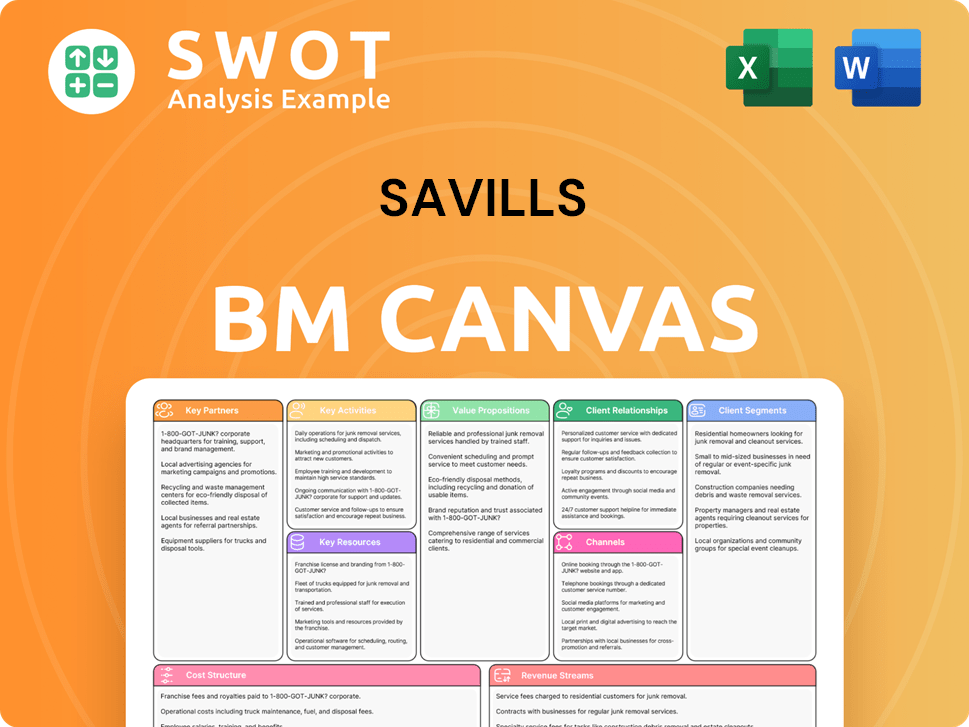
What Recent Changes Have Shaped Savills’s Ownership Landscape?
Over the past few years, the ownership profile of the company has evolved, marked by strategic leadership transitions and active share management. In April 2025, Mark Ridley, the Group Chief Executive, announced his retirement, with Simon Shaw, the Group Chief Financial Officer, set to succeed him in January 2026. This internal succession plan highlights the company's commitment to leveraging existing talent within its leadership structure. The company's approach to ownership includes share buyback programs, aimed at enhancing shareholder value.
In September 2024, the company initiated a share buyback program, targeting up to 13,048,000 ordinary shares, with an aggregate consideration of up to £19,572,000. This program is expected to conclude by July 1, 2025, or the 2025 AGM. While the 6-month share buyback ratio as of December 2024 was -0.18%, the overall strategy indicates a focus on returning value to shareholders through share repurchases. Furthermore, the company has also been involved in strategic acquisitions to strengthen its market position and diversify its portfolio.
| Metric | Details | Year |
|---|---|---|
| Acquisitions Completed | 14 acquisitions | As of April 2025 (3-year average) |
| Transactions by Savills Investment Management | €366 million | 2024 |
| International Capital in Scottish Hotel Sector | 60% of purchases | 2024 |
The company's strategic acquisitions, with an average of one per year over the past three years, reflect its growth strategy. The acquisition of Osborne King in April 2025 aligns with its expansion plans in Ireland. In 2024, Savills Investment Management completed €366 million in transactions, including acquisitions and divestments, diversifying its portfolio. These activities highlight the company's proactive portfolio management and responsiveness to market dynamics. For more insights, you can explore Revenue Streams & Business Model of Savills.
The company's ownership is characterized by a mix of institutional and individual shareholders. The company is a public company, traded on the London Stock Exchange.
Mark Ridley is the current Group Chief Executive, retiring at the end of 2025. Simon Shaw will succeed him as Group Chief Executive effective January 1, 2026.
Savills is a global real estate services provider with a significant presence in the market. The company's strategic acquisitions and market activities show its commitment to growth.
The company's financial performance is influenced by global real estate market trends. Savills' annual reports provide detailed financial information.
Savills Porter's Five Forces Analysis
- Covers All 5 Competitive Forces in Detail
- Structured for Consultants, Students, and Founders
- 100% Editable in Microsoft Word & Excel
- Instant Digital Download – Use Immediately
- Compatible with Mac & PC – Fully Unlocked
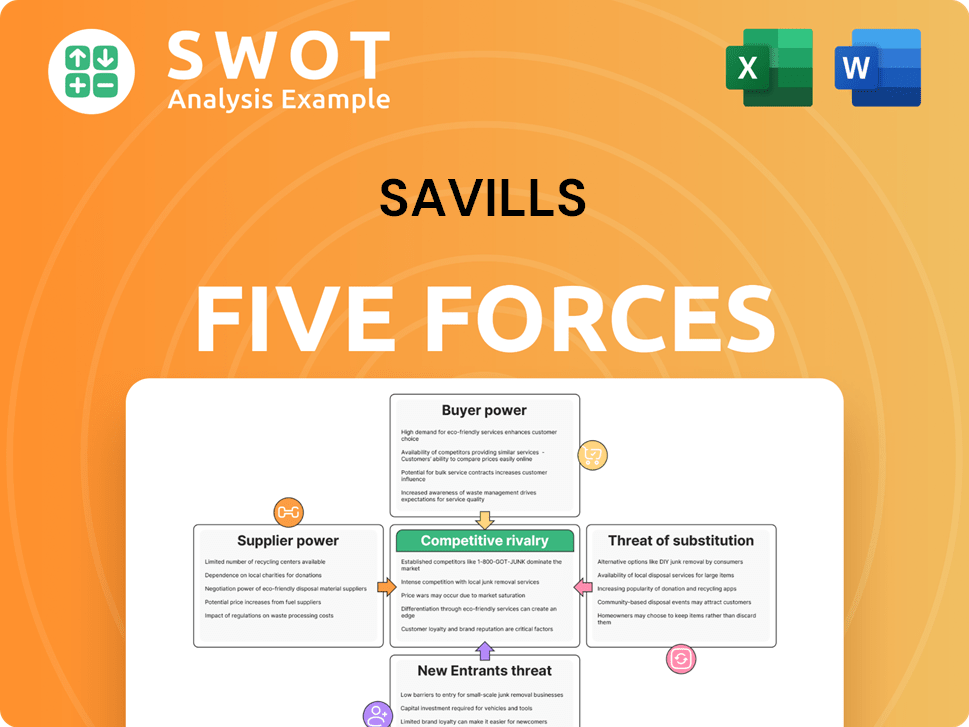
Related Blogs
- What are Mission Vision & Core Values of Savills Company?
- What is Competitive Landscape of Savills Company?
- What is Growth Strategy and Future Prospects of Savills Company?
- How Does Savills Company Work?
- What is Sales and Marketing Strategy of Savills Company?
- What is Brief History of Savills Company?
- What is Customer Demographics and Target Market of Savills Company?
Disclaimer
All information, articles, and product details provided on this website are for general informational and educational purposes only. We do not claim any ownership over, nor do we intend to infringe upon, any trademarks, copyrights, logos, brand names, or other intellectual property mentioned or depicted on this site. Such intellectual property remains the property of its respective owners, and any references here are made solely for identification or informational purposes, without implying any affiliation, endorsement, or partnership.
We make no representations or warranties, express or implied, regarding the accuracy, completeness, or suitability of any content or products presented. Nothing on this website should be construed as legal, tax, investment, financial, medical, or other professional advice. In addition, no part of this site—including articles or product references—constitutes a solicitation, recommendation, endorsement, advertisement, or offer to buy or sell any securities, franchises, or other financial instruments, particularly in jurisdictions where such activity would be unlawful.
All content is of a general nature and may not address the specific circumstances of any individual or entity. It is not a substitute for professional advice or services. Any actions you take based on the information provided here are strictly at your own risk. You accept full responsibility for any decisions or outcomes arising from your use of this website and agree to release us from any liability in connection with your use of, or reliance upon, the content or products found herein.